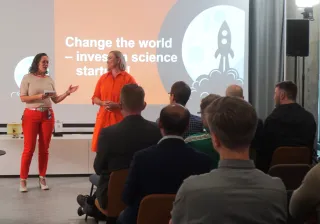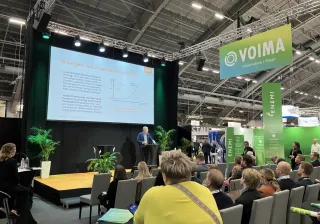Minister of Energy Kimmo Tiilikainen believes that emission limits will be tightened across the EU, when it becomes clear that slowing down global warming is more difficult than anticipated. In his view, emissions trading is the most effective way to reduce emissions, but a larger share of emissions should be brought under the scheme.
Finland has been at the forefront of forming a coalition of twenty nations to end the use of coal. Abandoning coal as a source of energy would achieve the same goal.
– This is one concrete step forward, says Kimmo Tiilikainen, Minister for Housing, Energy and Environment.
Finland has accelerated progress through its own example. The 2020 target for renewable energy as a share of total consumption was reached in 2014. The target was 38 percent and we are now at around 40 percent.
Last year, 47 percent of the electricity consumed in Finland was produced from renewable energy. The current national target for 2030 is half of this. The Minister of Energy points out that heating and transport present a greater challenge.
– With regard to renewable energy, wind power and solar energy are often highlighted as sources of electricity. But a bigger challenge lies in replacing coal and ending our oil dependency, says Tiilikainen.
Obligation to include renewables in fuel mixes
The approval of solid biomass as a renewable raw material for transport fuels has been a goal of Finland's; Finland and Sweden have worked hard to this end in the EU Parliament.
– The legislation now supports the achievement of our goals, the minister says.
A decision will be taken on the obligation to include renewables in transport fuel mixes this year. This would currently be the most powerful means of reducing traffic emissions and would help to achieve the renewable energy component of the emissions target.
A renewables obligation would also apply to fuel oil used for heating. The government's strategic policy sets a ten percent level for the share of renewables in fuel oil, but the related law and schedule are a work in progress. Industry players are included on the working group. In traffic fuels, a fuel mix requirement of 30 percent is being envisaged.
Ban on coal as early as 2025?
The current government programme already proposes the abandonment of coal as an energy source during the 2020s. The Ministry of Economic Affairs and Employment has commissioned an impact assessment of a coal ban. As part of this assessment, Minister Tiilikainen wanted to assess the effects of a ban on coal use by 2025.
The government will decide on its policy during the spring, in time for a bill to be presented to Parliament in the autumn.
The Energy Minister does not believe that a coal ban will affect the adequate supply of electricity for industry. Olkiluoto 3 will be in operation before the ban takes effect and will generate power on a different scale to coal-based production.
– Carbon is mainly used for district heating and there has been a lot of good news on that front in recent months. Oulun Energia is investing EUR 200 million in a combined heat and power plant, Kymijärvi 3 in Lahti is a biomass plant that will replace coal, and large investments are being made in Vantaa, says Tiilikainen.
However, coal is important to the security of fuel supply and Tiilikainen wants to include the crisis-preparation perspective in the legislation banning coal.
The target level will change before 2030
Finland's use of coal for energy forms part of the EU's emissions trading and emissions ceiling in general. Throughout the winter, industry representatives have been pointing out that lowering carbon dioxide emissions through a coal ban in Finland would allow higher emissions in other EU countries. This would not change the atmospheric carbon balance, despite the rise in energy production costs in the cold North.
– This assumption is theoretically correct, due to our common emissions trading system. But the energy industry's comment is based on a static appreciation of the situation. I think that the system is in a dynamic phase. The legislation will not remain the same for the next 13 years, but will change along the way, Tiilikainen speculates.
In addition, Finland can choose not to exercise its reduced emission rights, i.e. withdraw them from the market.
– Abandoning coal will require pioneering countries.
The Paris Climate Agreement includes a five-yearly assessment of emissions targets. The Minister of Energy assumes that the goal of limiting global warming to 1.5 degrees will be declared impossible at next autumn's climate summit.
– We will then discuss how to limit it to two degrees. I bet that it won't be long before the EU starts talking about tightening its emission reduction targets.
Finland has a legislative basis covering the period up to 2030. The ban on the use of coal is part of the preparations for the government's implementation of its energy and climate strategy.
– The target level will probably be changed. The sooner countries stop using coal for energy production, the easier it will be to achieve the targets.
Emissions trading to expand
– Half of emissions are outside the emissions trading scheme in the EU. The system includes industry and energy production, which have a tougher reduction target than others.
According to the Minister, this will lead to a situation in which a smaller proportion of emissions will be under effective control by 2030.
– Strengthening the targets will add to this mismatch, whereby the most effective control covers a smaller proportion of emissions, says Tiilikainen.
He also hopes for a discussion in the EU on what elements can be included in the emissions trading scheme. For example, this could include property-specific heating, traffic or machinery fuels.
– Within the EU, I intend to raise the issue of how emissions trading might cover a larger share of carbon dioxide emissions. This is a debate, not a ready-made model. The EU has enough time to consider where to lay each piece of the jigsaw, says Tiilikainen.
He regards the emissions trading system as the primary driving force in Finland too.
– The EU provides an even playing field, which is good for everyone. The Paris Treaty provides the starting point for bringing the systems of different continents together. This is a market-oriented direction which will cost-effectively target emission reduction measures. But the principle must be that the impact of emissions trading be extended to a greater proportion of emissions. I would like to promote that idea at EU level.
New technologies are needed
Prime Minister Sipilä's government is committed to making Finland a leader in the circular and bioeconomy.
– Our basic aim is to be at the forefront, because solutions are needed across the world. Research and development efforts are being directed towards this issue. It's about dividing up a small pie, but there is room for new development, Tiilikainen promises.
At the end of May, the Nordic countries will host the Clean Energy Ministerial in Copenhagen and Malmö, in which the participating countries are, in practice, the G20 and Nordic countries.
The meeting will provide updates on the latest developments in clean energy.
For decades ahead, the Paris Climate Agreement will provide a strong basis for developing new technologies from the sustainable development perspective.
– Never before have people been so strongly convinced of the need for new technologies. In that sense, this is the time for solutions. It is about how companies react to the challenge and how the state feeds demand for R&D, to enable Finnish companies to succeed.
According to the Minister of Energy, the next five years will be crucial to how Finland fares in this competition.
– The huge need for development has been noticed everywhere, but we have several advantages. Comparisons of education, high technology and the state of the environment reinforce the idea that we have expertise. There is a great deal of interest in Finland.
According to Tiilikainen, Finland and the Nordic countries have much to offer, but working solutions are needed.
– We have solutions that have yet to be commercialised, he says.
Moving the carbon ban forward would increase heating prices locally
Coal is only used to a significant extent in eight Finnish localities. Abandoning coal would not impose costs on many people, since its use as an energy source is also decreasing due to market forces. The greatest impact would be in Helsinki, Vaasa and Espoo.
Under assignment from the Ministry of Economic Affairs and Employment, Pöyry Management has investigated the impacts of a ban on coal. The report was handed over to Minister of Energy Kimmo Tiilikainen in late March.
Abandoning coal as an energy source features in the government's energy and climate strategy, but there are two possible timetables. Coal will be abandoned either by 2030 or by 2025.
The biggest coal users are in eight locations. Helsinki, Espoo, Vantaa, Vaasa, Naantali, Lahti, Jakobstad and Kirkniemi accounted for 90% of the coal used in Finland in 2016.
Pöyry estimates that the capacity of coal-fired heat production will fall significantly on market terms by 2030, but replacement investments will mainly occur in the second half of the 2020s.
Coal-fired energy production totalled 22TWh in 2016, but will fall to 5-7TWh by 2025 and then to just 3.5TWh in 2030. Coal-fired district heating capacity will fall from 2,055MW to 1,100 megawatts by 2025, and to 480 megawatts five years later.
A ban on the use of coal in energy production in 2025 would have a major impact on the production of district heating, especially in Vaasa and Helsinki, and cause additional costs in Espoo, Vantaa and Turku. Based on the assumptions applied in the report, the overall impact could rise to EUR 200 million in 2024–2033.
One factor contributing to uncertainty in the impact assessment's results is the assumption that biomass would be available to replace coal in the Helsinki metropolitan area. Bringing the coal ban forward to 2025 would increase the use of biomass by 2–2.2TWh, some of which would be imported. The use of natural gas would increase by 1.6–2.6TWh.





